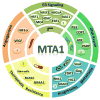Role of MTA1 in cancer progression and metastasis
- PMID: 25344802
- PMCID: PMC4245458
- DOI: 10.1007/s10555-014-9515-3
Role of MTA1 in cancer progression and metastasis
Abstract
The MTA1 protein contributes to the process of cancer progression and metastasis through multiple genes and protein targets and interacting proteins with roles in transformation, anchorage-independent growth, invasion, survival, DNA repair, angiogenesis, hormone independence, metastasis, and therapeutic resistance. Because the roles and clinical significance of MTA proteins in human cancer are discussed by other contributors in this issue, this review will focus on our current understanding of the underlying principles of action behind the biological effects of MTA1. MTA proteins control a spectrum of cancer-promoting processes by modulating the expression of target genes and/or the activity of MTA-interacting proteins. In the case of MTA1, these functions are manifested through posttranslational modifications of MTA1 in response to upstream signals, MTA1 interaction with binding proteins, and the expression of target gene products. Studies delineating the molecular basis of dual functionality of MTA1 reveal that the functions of MTA1-chromatin-modifying complexes in the context of target gene regulation are dynamic in nature. The nature and targets of MTA1-chromatin-modifying complexes are also governed by the dynamic plasticity of the nucleosome landscape as well as kinetics of activation and inactivation of enzymes responsible for posttranslational modifications on the MTA1 protein. These broadly applicable functions also explain why MTA1 may be a "hub" gene in cancer. Because the deregulation of enzymes and their substrates with roles in MTA1 biology is not necessarily limited to cancer, we speculate that the lessons from MTA1 as a prototype dual master coregulator will be relevant for other human diseases. In this context, the concept of the dynamic nature of corepressor versus coactivator complexes and the MTA1 proteome as a function of time to signal is likely to be generally applicable to other multiprotein regulatory complexes in living systems.
Conflict of interest statement
Figures





References
-
- Toh Y, Pencil SD, Nicolson GL. A novel candidate metastasis-associated gene, mta1, differentially expressed in highly metastatic mammary adenocarcinoma cell lines. cDNA cloning, expression, and protein analyses. J Biol Chem. 1994;269(37):22958–22963. - PubMed
-
- Kumar R, Wang RA, Bagheri-Yarmand R. Emerging roles of MTA family members in human cancers. Semin Oncol. 2003;30(5 Suppl 16):30–37. - PubMed
-
- Bowen NJ, Fujita N, Kajita M, Wade PA. Mi-2/NuRD: multiple complexes for many purposes. Biochim Biophys Acta. 2004;1677(1–3):52–57. - PubMed
-
- Manavathi B, Kumar R. Metastasis tumor antigens, an emerging family of multifaceted master coregulators. J Biol Chem. 2007;282(3):1529–1533. - PubMed
Publication types
MeSH terms
Substances
Grants and funding
LinkOut - more resources
Full Text Sources
Other Literature Sources
Miscellaneous

